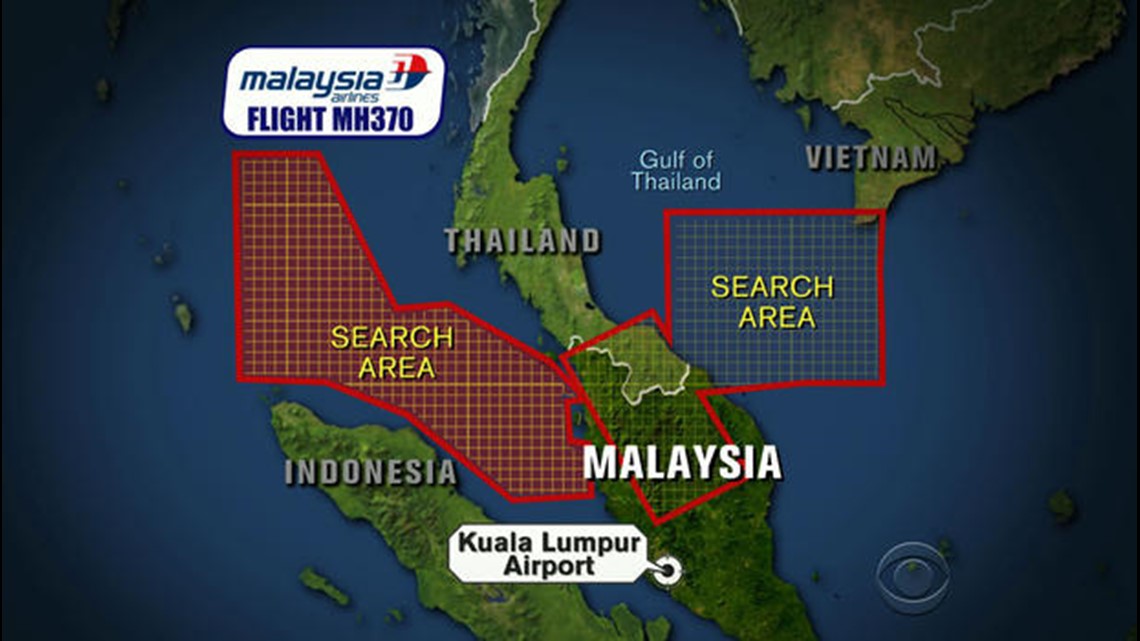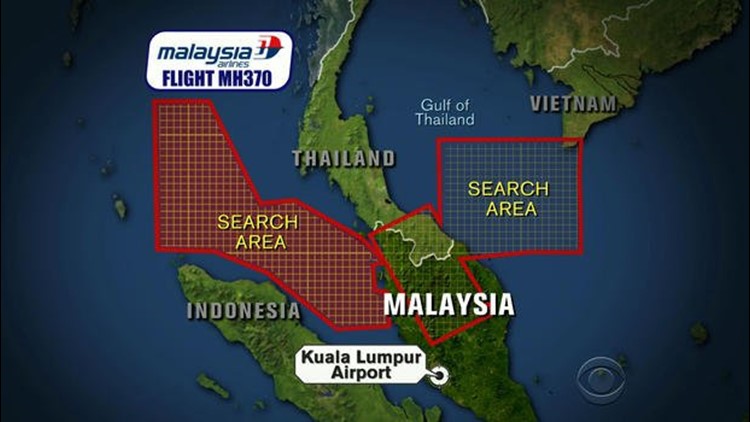CBS News – Malaysia’s government denied a report by the Wall Street Journal on Thursday that the Boeing 777 used in Malaysia Airlines Flight 370 continued sending data to the ground long after it fell off radar screens, but with no confirmation from the company the Journal said received those data transmissions, the report has raised new questions about the search for the missing international flight.
“This opens up a whole host of new questions,” CBS News aviation and safety expert Captain Chesley “Sully” Sullenberger said on “CBS This Morning.”
“There’s still much we don’t know,” said Sullenberger, explaining that only Boeing, or the manufacturer of the engines on the aircraft, Rolls Royce, could confirm or deny the report. According to the Malaysian transport minister, both companies deny that data transmissions were made after the flight dropped off radar on Saturday.
“Those reports are inaccurate,” said Transport Minister Hishamuddin Hussein. He said the last transmission of data from Flight 370 came before the plane’s signal disappeared from radar and communications with the crew were lost, and indicated “everything was normal.”
“As far as Rolls Royce and Boeing are concerned, those reports are inaccurate,” said Hussein.
According to the Journal report, engine data that includes altitude and speed but not direction or position were sent from Malaysian Airlines Flight 370 for four hours after the plane went missing.
CBS News contacted Rolls Royce twice on Thursday morning at the company’s U.K. headquarters. The company refused to comment on the Wall Street Journal report.
Aviation experts tell CBS News the engine data would have been transmitted to Malaysia Airlines ground control, and then possibly on to Rolls Royce, by a decades-old system known as ACARS. The simple data transmission system is widely used in commercial aviation, and sends automated messages on virtually every operating system on an aircraft to the ground at regular intervals.
An article in the New Scientist, published on Tuesday, the Boeing 777-200 that left Kuala Lumpur for Flight 370 sent just two ACARS data transmissions to the ground, one just after takeoff and a second after it reached cruising altitude. The article did not mention any further transmissions.
Meanwhile, the search continued for the missing jet, with very little to go on.
Planes dispatched Thursday to examine an area where Chinese satellite images showed what might have been debris from the missing Malaysia Airlines Flight 370 found nothing, officials told CBS News.
The Malaysian Air Force director of operations told CBS News in Kuala Lumpur that planes sent up based on the Chinese satellite images from Sunday, the day after Flight 370 went missing south of Vietnam, had located no debris.
Later Thursday, Malaysian civil aviation chief Azharuddin Abdul Rahman reiterated the latest bad news in the search for the plane. “There is nothing. We went there, there is nothing,” he told reporters.
Separately, a Reuters journalist who was on board a Vietnamese search aircraft dispatched to the same area Thursday, said no debris was spotted.
“Aircraft repeatedly circled the area over the South China Sea but were unable to detect any objects,” Reuters reported.
The hunt for Flight 370 has seen numerous false leads since it disappeared with 239 people aboard hours after leaving Kuala Lumpur for Beijing on Saturday. Malaysia’s military said it might have turned back and headed into the upper reaches of the Strait of Malacca or beyond, based on a radar blip showing an apparent aircraft on the western side of the Malaysian peninsula, but officials have yet to confirm whether the radar blip was in fact the Boeing 777, and it quickly disappeared from the screen.
The notion that the still-unexplained radar detection could have been Flight 370 was lent more credence on Thursday, however, as sources close to the investigation told CBS News that upon reviewing the Malaysian military’s radar data, they agreed that the search area should be expanded to the western Strait of Malacca. Officials in Malaysia said earlier this week that the search was being extended into the Strait, after the possible detection of an unidentified aircraft on the military radar.


The debris in the Chinese images was not far from the last confirmed position of the plane, between Malaysia and Vietnam. The images and coordinates were posted on the website of China’s State Administration of Science, Technology and Industry for National Defense.
A Xinhua report said the images, from around 11 a.m. on Sunday, appear to show “three suspected floating objects” of varying sizes in a 12-and-a-half mile radius, the largest about 79-by-72 feet, off the southern tip of Vietnam.
Malaysia’s civil aviation chief, Datuk Azharuddin Abdul Rahman, said Malaysia had not been officially informed by China about the images, something he said was a “a breach of protocol.”
He noted the general area had been searched several times and the images were taken on Sunday. “There have been lots of reports of suspected debris,” he said.
Li Jiaxiang, chief of the Civil Aviation Administration of China, said later China had yet to confirm any link between the floating objects and the plane.
Malaysia has come under some criticism for its handling of the search, which currently covers 35,800 square miles and involves 12 nations.
On Wednesday, Malaysian government officials told passengers’ relatives that the last words of the captain to air traffic control indicated nothing was wrong. But with no confirmed trace of the jet, the words did nothing to calm waiting friends and families.



